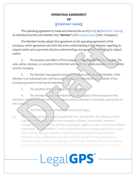What to Do When a Supplier Misses a Critical Delivery Deadline
Your online store is gearing up for a Black Friday sale, with hundreds of orders banking on a supplier delivering 1,000 units of your best-selling...
7 min read
LegalGPS : May. 13, 2025
You’ve hired a contractor, agreed on a timeline, and planned your project around their promised completion date. But as the deadline approaches, the work is nowhere near done. Missed deadlines can throw your project into chaos, inflate costs, and test your patience. Whether it’s a home renovation, commercial build, or landscaping job, contractor delays are a common headache for homeowners, business owners, and property managers.


Legal GPS Pro
Protect your business with our complete legal subscription service, designed by top startup attorneys.
The good news? You can take control of the situation with a clear, actionable plan. This guide walks you through every step to address a contractor who misses a deadline, from assessing the delay to pursuing legal remedies if needed. With real-world examples and expert Pro Tips, you’ll learn how to get your project back on track and prevent future delays. Let’s protect your time, budget, and peace of mind.

Consulting Agreement
Download our Consulting Agreement Template to formalize your consulting services. Protect your business with a clear comprehensive contract.
Trusted by 1,000+ businesses to safeguard their LLCs.
Before taking action, understand the delay’s scope and cause. A thorough assessment lays the groundwork for a resolution.
Your contract is your legal anchor. Check for:
Gather evidence to support your case:
Contact the contractor to understand the delay. Common reasons include:
Emma, a homeowner, hired a contractor for a $30,000 kitchen remodel with a six-week timeline. At week eight, the countertops were missing, and cabinets were half-installed. Emma reviewed the contract, which specified a completion date and a $200/day late fee. She documented the site with photos and saved emails where the contractor cited supply delays. This preparation helped her approach the contractor with confidence.
Use this checklist to stay organized:
Clear, professional communication can often resolve delays without escalation. Your goal is to understand the contractor’s plan and set firm expectations.
Reach out via email or phone within 1–2 days of a missed deadline. Be polite but direct:
If the contractor’s response is vague or unsatisfactory, send a written notice. Include:
Maintain a calm tone to encourage cooperation. Avoid threats or accusations, as they can sour negotiations or weaken your legal position.
James, a retail store owner, faced a two-week delay on a $50,000 renovation. He emailed the contractor, citing the contract’s timeline and requesting a catch-up plan. The contractor admitted to labor issues and proposed hiring a subcontractor. James’s professional approach led to an agreement, and the project finished only 10 days late.
Your notice should include:
If communication doesn’t resolve the delay, negotiation can get the project back on track without legal action.
Offer solutions like:


Legal GPS Pro
Protect your business with our complete legal subscription service, designed by top startup attorneys.
If negotiations stall, suggest mediation through a local dispute resolution center or industry association. A mediator facilitates a fair agreement, often for $100–$500, split between parties.
Any new terms—revised timelines, payments, or penalties—must be documented in a contract amendment, signed by both parties.
Sofia, a property manager, dealt with a contractor who missed a three-week deadline on a $100,000 apartment complex repair. Sofia negotiated a deal: the contractor paid a $5,000 penalty but secured a two-week extension with no further fees. The agreement was signed as a contract addendum, and the project finished on time.
Use these strategies:
If negotiation fails, enforce the contract’s remedies to address the delay.
Invoke late fees or liquidated damages as outlined in the contract. For example:
If the contract allows, withhold payment for incomplete work. Ensure:
If delays persist, terminate the agreement per the contract’s terms. This typically requires:
Liam, a real estate developer, faced a four-week delay on a $500,000 commercial build. The contract included a $1,000/day liquidated damages clause. Liam enforced $20,000 in penalties, which offset losses from delayed tenant move-ins. The contractor finished the project to avoid further deductions.
To terminate safely:
When remedies fail, legal action may be necessary to recover losses from delays.
For losses under your state’s limit (e.g., $7,500 in California, $20,000 in Texas), file a small claims case. Steps include:
For larger claims, hire an attorney to file a breach of contract lawsuit. They can also pursue:
If the contract requires arbitration, file a claim through an agreed-upon arbitrator. Mediation is a less formal alternative, often faster than court.
Noah, a homeowner, hired a contractor for a $15,000 deck project, but the contractor abandoned it after missing a one-month deadline. Noah filed in small claims court, presenting the contract, photos of the unfinished deck, and emails. He won $10,000 for costs and damages.
To build your case:
Proactive measures can minimize the risk of missed deadlines.
Include:
Before hiring:
Maria, a gym owner, avoided delays on a $200,000 facility expansion by vetting contractors thoroughly. She checked references, included a $500/day penalty in the contract, and used Buildertrend for weekly updates. The project finished two days early.
Use these tools:
A contractor missing a deadline can disrupt your plans and budget, but you’re not powerless. By assessing the situation, communicating effectively, negotiating solutions, enforcing remedies, and pursuing legal action when needed, you can get your project back on track. Better yet, strong contracts, thorough vetting, and proactive monitoring can prevent delays from derailing your next project.
The biggest question now is, "Do you need a lawyer for your business?” For most businesses and in most cases, you don't need a lawyer to start your business. Instead, many business owners rely on Legal GPS Pro to help with legal issues.
Legal GPS Pro is your All-In-One Legal Toolkit for Businesses. Developed by top startup attorneys, Pro gives you access to 100+ expertly crafted templates including operating agreements, NDAs, and service agreements, and an interactive platform. All designed to protect your company and set it up for lasting success.

Legal GPS Pro
Protect your business with our complete legal subscription service, designed by top startup attorneys.
|
Premium Template
Single-use Template |
Legal GPS Pro
Unlimited Access, Best Value |
|
|
| Choose Template | Learn More |
| Trusted by 1000+ businesses | |

Your online store is gearing up for a Black Friday sale, with hundreds of orders banking on a supplier delivering 1,000 units of your best-selling...

You’ve hired a web developer to build your startup’s website, and things are going smoothly—until they stop responding. Emails go unanswered,...

Your startup signed a $10,000 contract with a marketing firm to boost your brand, but budget cuts force you to pull the plug. Canceling feels like...